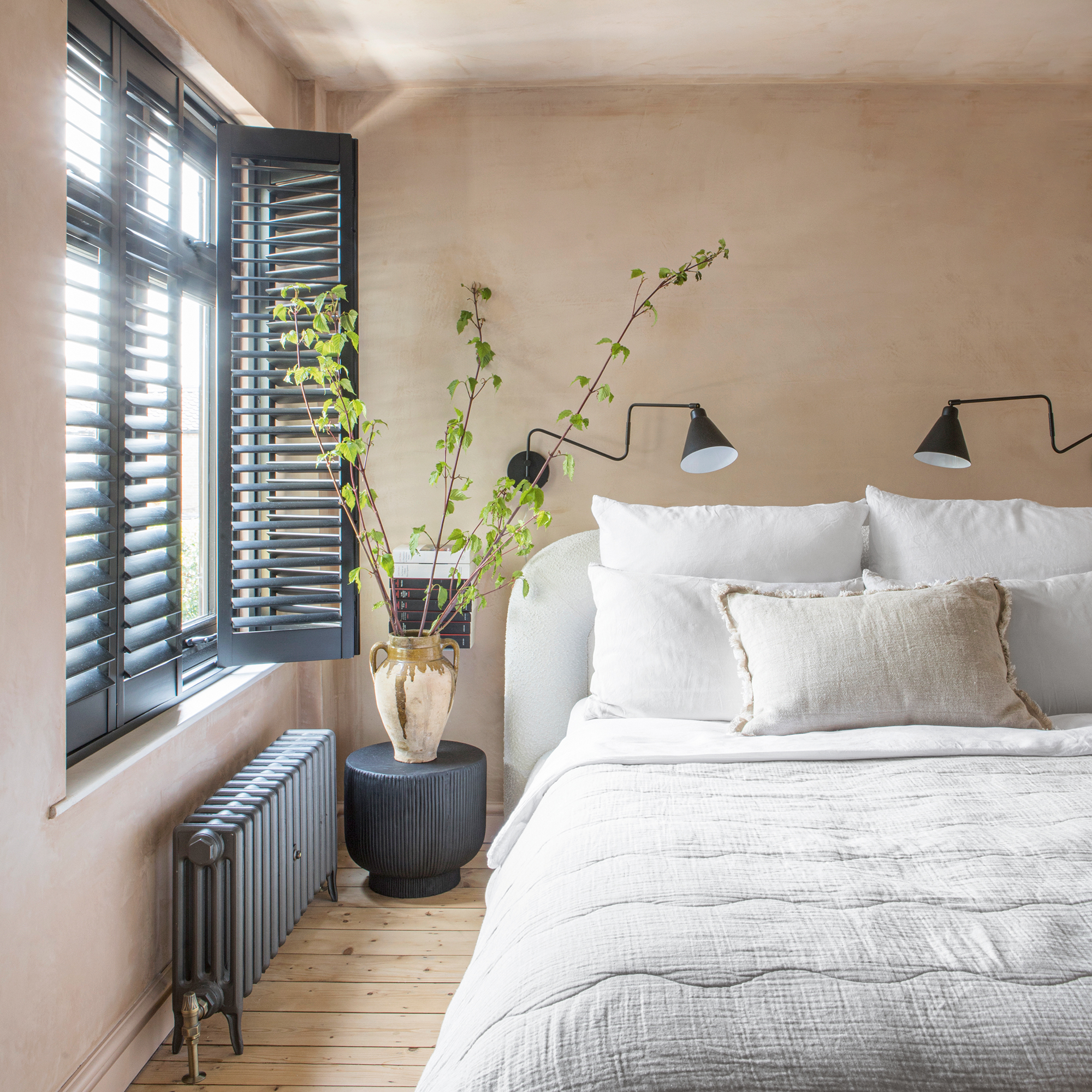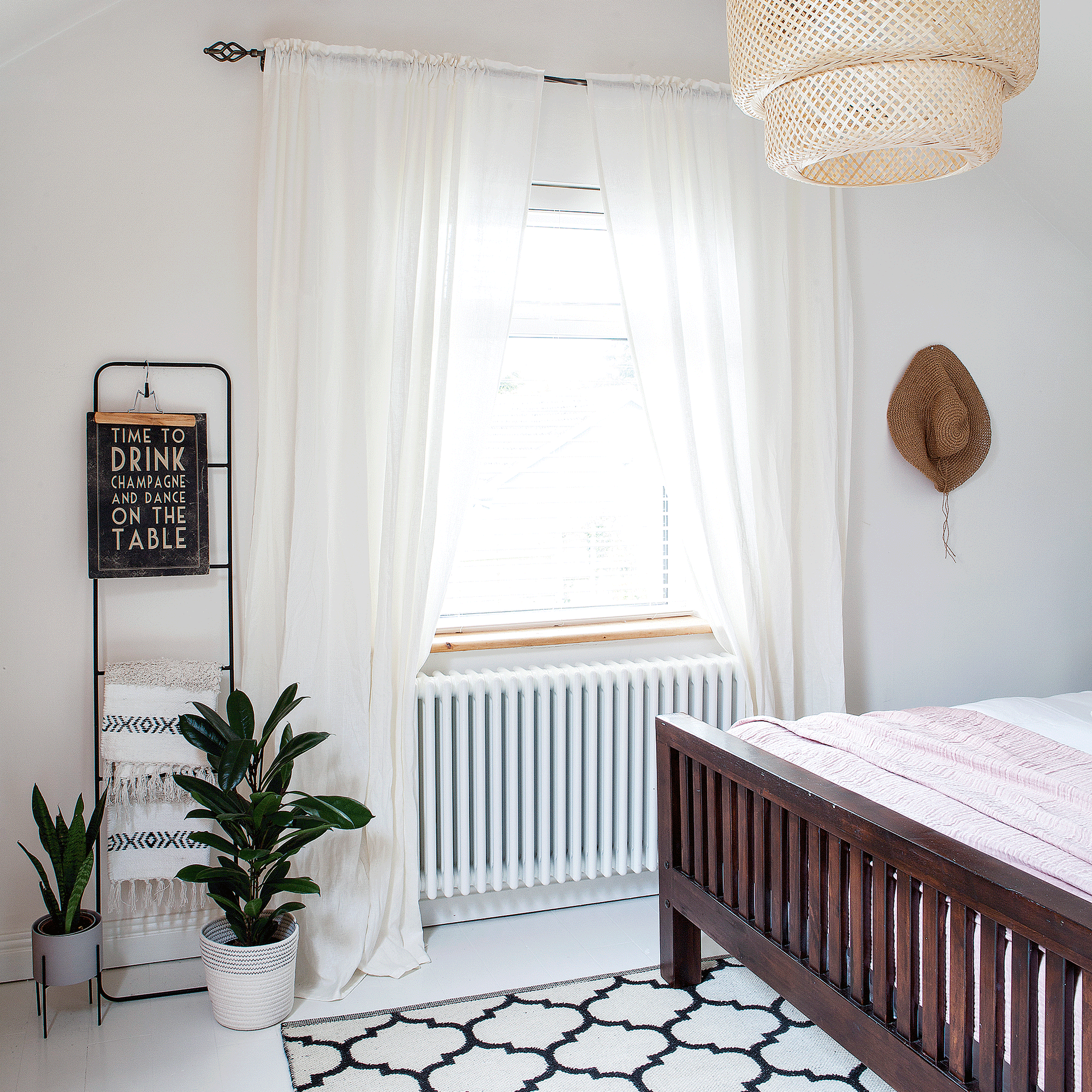How to stop damp in a bedroom - 10 foolproof ways to keep mould at bay
These small changes can make a big difference


Your home is constantly dealing with an onslaught of moisture. And while a little bit of condensation is manageable, too much can result in dangerous mould that threatens your health and the integrity of your home. So, knowing how to stop damp in a bedroom can protect your home from further problems.
When you’ve spent time and money bringing your bedroom ideas to life, the last thing you want is for wet walls, damp patches, and mould to ruin your hard work. However, bedrooms are often overlooked when it comes to dampness as many homeowners focus their attention on obvious moisture-filled rooms such as the bathroom and the kitchen.
Bedrooms are extremely susceptible to excess moisture, even just breathing out at night can add to the moisture levels. As we spend one-third of our lives in bed, it’s important to get rid of damp in a bedroom as soon as you spot the signs.
How to stop damp in a bedroom
‘Bedrooms typically exist in low-pressure zones within a home. This means that, compared to areas like bathrooms and kitchens where moisture is being generated, bedrooms tend to have lower air pressure,’ explains Jack Garratt, Managing Director at Garratts Damp & Timber.
‘Because moisture is an airborne substance, it naturally moves from areas of higher pressure to those with lower pressure, putting bedrooms in the frontline of excessive moisture.’
However, you don’t have to live with this excessive moisture, and below, you’ll find top tips on how to stop damp in a bedroom.
1. Understand the root cause
There’s nothing worse than living in a damp house, and while many of the tips and tricks in this list will help stop damp in a bedroom, they won’t necessarily solve any serious underlying issues. That’s why Stephen Day, the Director of iHeat, suggests trying to understand the root cause of the damp first.
Sign up to our newsletter for style inspiration, real homes, project and garden advice and shopping know-how

He says, ‘Damp in bedrooms can often be traced back to a few key factors such as inadequate ventilation, external leakage, or condensation, so it’s important to find out what is causing it and tackle it fast before it can cause irreversible damage to your belongings or health.’
‘Often, the cause of damp can be something as simple as a small leak or a crack in the wall, so regular maintenance is key. To help prevent this issue, make sure to check your home's exterior walls and plumbing regularly. Something small, such as a blocked or broken drain pipe or a small crack by your windowsill, can go unnoticed for months and cause irreparable damage before you notice them in your bedroom.’
It’s also a good idea to clean your gutters on a regular basis, as blocked gutters can also result in leaks and condensation in your bedroom.
2. Move your furniture
Unless you’re lucky enough to have a giant master suite, there’s a high chance that you have a relatively small bedroom - but a lot of furniture to fit in it. From double beds to wardrobes and bedside tables, bedrooms are normally chock-full of things.
This can be a real problem if you’re trying to stop damp in a bedroom, as explained by Jenny Shu, Interiors Expert at Property Rescue. She says, ‘Damp can be a real problem at this time of year, but there are a few ways to use your furniture and balance functionality with style to help reduce dampness in your bedroom and combat moisture.’
‘Improving ventilation is the first step to ensuring freshness. Keep a slight gap between your furniture and the walls to allow for better airflow, this will help reduce the risk of trapped moisture and mould growth.’

She also suggests ditching your bedroom carpet in favour of your natural floorboards - with a bedroom rug idea thrown in for good measure, too. ‘Thick rugs can not only be stylish but absorb less moisture than wall-to-wall carpeting, especially if you opt for synthetic fibres or natural materials with moisture-resistant properties. They’re easy to clean and great to style in any bedroom.’
3. Use a dehumidifier
It’s easy to assume that cold and wet weather is the main contributor to a damp bedroom. And while it’s certainly a factor, what many people fail to realise is that one of the main causes of condensation and moisture in bedrooms is humans themselves.
It’s suggested that the average person adds around 200ml of water into the air every single night as they’re breathing, and if you don’t fight back against this extra moisture, you could see your bedroom riddled with damp. Of course, we can’t stop breathing to combat this moisture, which is where the best dehumidifiers come into play instead.

Plumbing and heating expert Peter Clayton from Trade Plumbing explains, ‘Using a dehumidifier to absorb excess moisture is a simple method for putting a stop to dampness in your bedroom. To extract the maximum amount of moisture, place your dehumidifier in a location with free-flowing air, the centre of a room is usually best, but this may be a potential hazard if you get up often in the middle of the night. To achieve the ideal indoor humidity levels, use your dehumidifier for roughly 12 hours a day.’
If you don’t know which dehumidifier to buy the main thing for look for when choosing the best dehumidifier for your bedroom is one that is quiet and discreet.
4. Declutter your space
You might not realise it, but there’s a high chance that your bedroom is full of clutter. From unwanted clothes stuffed into your wardrobe to the stack of unread books sitting on your bedside table, all of this stuff can be troublesome if you’re dealing with damp in your bedroom.
Ava Wilson, Chief Editor at Unclutterer, explains, ‘A cluttered room can exacerbate dampness issues as it hinders air circulation, which is vital in combating dampness. So, implementing smart storage solutions could dramatically improve your bedroom's damp issues.’

‘For example, using vacuum-sealed bags for storing seasonal clothing like jumpers or coats under the bed can help reduce clutter while keeping items dry. This will also allow air to circulate between all the items in your wardrobe, helping prevent any build-up of damp or mildew that could cause staining or nasty smells.’
‘Open shelving units, as opposed to bulky wardrobes, can also promote better air movement as this again allows air to circulate freely. If you have closed storage - such as a bookshelf - ensure that items are not tucked too close to the back or sides of any shelving panels. This way, air can still circulate, and you’re less likely to suffer from damp spots.’

Ava Wilson, Unclutterer’s Chief Editor with 25 years in cleaning, started with a mop and now leads a team of 20. Merging hands-on experience with management expertise, she transforms cleaning into inspiring lessons. Ava's eco-focused insights make Unclutterer a go-to for sustainable cleaning wisdom.
5. Maintain airflow
As damp conditions are largely prevalent during the wetter and colder months, the idea of opening up your windows in December and January may send a literal shiver down your spine. However, maintaining a constant airflow and improving ventilation are some of the best ways to stop dampness in a bedroom.
Nicholas Auckland, heating expert at Trade Radiators explains, ‘If there's nowhere for the warm air in your home to go, then it'll find a resting point on cold windows, walls and furnishings and create condensation there.’
‘Condensation is normal, but it should be able to exit your home without sitting and creating a damp environment. So, frequently open windows, and make sure your windows can be opened in a vent setting.’
‘If you want your home to stay warm while you have windows open, then it's recommended that you open the windows in one room while you close all internal doors. In a bedroom, you could open windows after you wake up in the morning or before you go to sleep.’
But if you feel like your windows aren’t quite cutting it, Construction company C R Build and Matthew Walsh Painting & Decorating suggest, ‘Air brick vents in rooms can help to control the flow of air, helping the circulation of air within your room. Seek advice from a professional if you feel this could benefit your home.’

Nicholas Auckland is a heating and energy expert with over 10 years of experience in the industry, as well as the Managing Director of Trade Radiators. Nicholas is dedicated to finding the best heating solutions for every need, as well as optimising energy usage, reducing costs and helping others live with lower-cost energy bills.
6. Wipe condensation as it appears
The topic of whether you should wipe condensation off windows or not is a tough one. In the summer and the warmer months, there’s no real need to wipe condensation off your windows as it should just go away on its own.

However, the answer is a little different during the colder months - especially if you want to know how to stop damp in a bedroom.
Sonia Patel, Marketing Lead for Russell Hobbs at Product Care Group, explains, 'Whilst wiping off condensation may not completely solve the underlying humidity issue in your home, it’s generally a good idea to wipe condensation off of your windows when it forms. By regularly removing it, you can also prevent water damage to your window frames.'
Thankfully, this is a pretty easy task. And while you can’t go wrong with using a microfibre cloth, the Ideal Home team will always advocate for the Kärcher WV 1 Window Vac (which most of the team owns!)
7. Keep your bedroom warm
With energy bills rising, heating your home in the winter is a double-edged sword. Although you want to save money and save energy, you also want to stay warm. So, what do you do? Nicholas maintains that you don’t have to do anything drastic to keep warm, keep your energy bills down, and also keep damp at bay in your bedroom.

His solution is to keep your bedroom at a constant temperature rather than allowing it to get too hot or too cold. He says, ‘The colder any surfaces are, the more likely it is that condensation will form. This is because condensation forms when warm air hits a cold surface, so eliminating these cold surfaces is essential.’
‘Make sure to keep your bedroom heated consistently. 18 degrees is ideal, but as long as it doesn’t get below 13C-14C, it should make a difference.’
Of course, you don’t even have to rely on your central heating to maintain this consistent temperature. If you don’t want to keep your boiler on all day, you could use one of the best electric heaters to keep the temperature stable.
8. Tackle the moisture in your bathroom
I live in a Victorian terrace house, and its early 1900s construction and layout means that my bathroom is on the ground floor. Because of this, I don’t have to worry too much about bathroom steam reaching my bedroom on the top floor.
However, most people live in houses with en-suites or bathrooms just steps away from their bedrooms. This can pose a serious problem if you’re trying to keep damp out of your bedroom as this excess steam will quickly make its way into your bedroom and add extra moisture to the air.
Peter says, ‘Many homeowners fail to realise that the cause of dampness may originate outside of the bedroom and be created in other areas of the home. Humid environments like bathrooms are home to a lot of moisture due to daily activities, like showering.’
‘Extractor fans ensure that this moisture is removed from the bathroom and discarded outside of the home, however, without an extractor fan the moisture will likely travel throughout the remainder of the home, making its way to the bedroom. This is especially true for bedrooms that have an ensuite.
‘To avoid this ensure that your bathroom has an extractor fan that is turned on when showering. Alternatively, if you don't have a fan then simply close your bathroom doors after showering and open a window to allow the moisture to escape.’
9. Dry clothes strategically
We all know that drying your clothes indoors can pose a danger to your home and health, but what are you supposed to do when it’s cold and raining? When you can’t hang your washing outside, and you don’t have a tumble dryer, drying your washing inside is the only option you have.
However, you don’t have to dry your clothes on an airer in your bedroom or hang your clothes on the radiators in your bedroom for it to impact your sleeping space. Drying your clothes anywhere in your home could ultimately lead to excess moisture in your bedroom, which can then contribute to damp and mould.
Nicholas says, ‘Dry clothes inside strategically as it's vital that you can dry the clothes without any negative implication. You should open windows or turn on your dehumidifier, place clothes near a heat source and make sure to keep internal doors closed.’
You could even take advantage of one of the best heated clothes airers and a dehumidifier at the same time, as a combination of both was deemed the best option in our heated airers vs dehumidifiers debate.
10. Make use of dehumidifying plants
You probably don’t need too much convincing to add more plants to your home, but if you want to stop damp in a bedroom and keep condensation at bay, you might want to be a bit pickier when it comes to the plants you choose.

There are so many plants that reduce condensation and damp, and these can be both practical and beautiful additions to your bedroom.
John Cutts, glass expert at MeandMyGlass.co.uk says, ‘It’s always worth getting houseplants like spider plants and orchids, which are known to help reduce moisture in the air to make condensation more manageable. For the best results, have them placed on the windowsill.’
FAQs
How do I fix damp in my bedroom?
If you already have damp in your bedroom, you first need to identify the cause of the excess moisture before you can fix it. To do this, check the exterior of your home, looking for cracks in the rendering, broken roof tiles, or leaking guttering. If you spot anything unusual, always get it fixed - and this may fix the damp in your bedroom.
However, if the damp in your bedroom is simply caused by wet weather, cold temperatures, and excess moisture, your main objective is to remove as much of this excess moisture as possible. You can do this by airing out your room and allowing for constant air flow, using a dehumidifier, removing condensation, keeping your bedroom at a constant temperature, and moving furniture away from the walls.
Why is there so much moisture in my bedroom?
Every night, we put moisture into the air of our bedrooms without realising it. In fact, the average human contributes 200ml of water to the air while they’re sleeping, just by breathing. This, alongside wet weather conditions and moisture from other rooms in the house, means that bedrooms often struggle with a high level of moisture.
Moisture is especially bad in bedrooms because they are low-pressure zones. This means that moisture moves from higher pressure zones (such as the bathroom and the kitchen) up to bedrooms. So, it’s down to you to ensure that this moisture level doesn’t get too high.
Take this as your sign to tackle the damp in your bedroom once and for all.

Lauren Bradbury has been the Content Editor for the House Manual section since January 2025 but worked with the team as a freelancer for a year and a half before that. She graduated with a Bachelor’s degree in English and Creative Writing from the University of Chichester in 2016. Then, she dipped her toe into the world of content writing, primarily focusing on home content. After years of agency work, she decided to take the plunge and become a full-time freelancer for online publications, including Real Homes and Ideal Home, before taking on this permanent role. Now, she spends her days searching for the best decluttering and cleaning hacks and creating handy how-to guides for homeowners and renters alike, as well as testing vacuums as part of her role as the Ideal Home Certified Expert in Training on Vacuums, having spent over 110 hours testing different vacuum models to date!